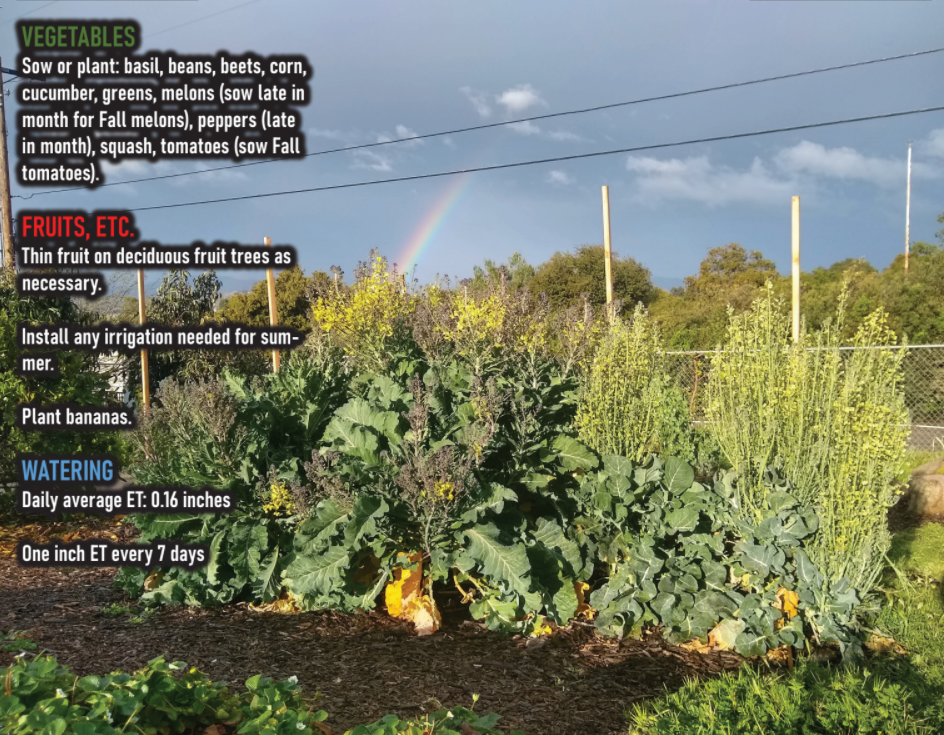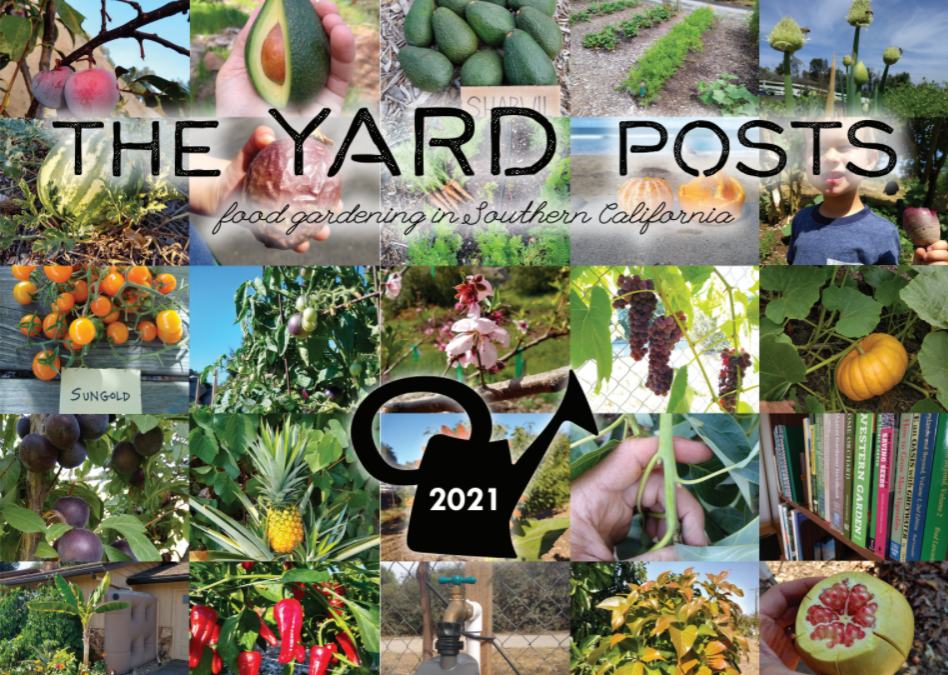The new calendars are on their way! Last year, I decided to print and sell the gardening calendars that I’d been making for myself for years. This year, I’m in the process of having a 2021 version printed, which will have all new photos, a few tweaks to the information, and an extra page for notes.
It is $25 with free shipping. Here is the page for the new 2021 gardening calendar in case you’re already ready to order.
What is in the calendar?
The cover of the calendar is shown above. And here is a sample page for the month of April:

For each month, I list which vegetables to sow or plant; timely tasks related to growing and caring for fruit trees, vines, and berry bushes; and guidance on watering.
My goal with the calendar is to provide the above information, at a glance, for each month so we don’t have to search on the internet or thumb through a book.
The information comes entirely from firsthand experience or is based on firsthand use (the watering information). I haven’t copied and pasted text from some online gardening calendar. If I say, for example, sow carrots in November, it is because I’ve successfully sowed carrots in November in multiple garden locations multiple times. If I say, graft avocados in March, it’s because I’ve done that successfully in many Marches.
Why the calendar format?
I put this information into calendar format because I like to have a calendar on which to record doings in the yard. I take notes on when I planted certain vegetables, when and how much I watered, when I harvested, etc. Here are my notes on the May 2020 calendar page:

Which zones is the calendar geared for? (Define “Southern California”)
My gardens in Southern California have been located about two miles from the ocean in San Diego as well as about twenty miles inland in North San Diego County.
Additionally, I frequently observe other gardens in the region. I visit Carpinteria at least once every year and visit gardens and orchards there, for example. Carp is in Santa Barbara County, the north end of Southern California. Also, I visit family and friends and their gardens throughout the year in every other county from Carp down to the Mexican border.
So where I believe the calendar’s information is applicable — which is my definition of Southern California — is Santa Barbara down to Imperial Beach and inland to the mountains. As for Sunset Zones, this would be 18 through 24. As for USDA Zones, this would be 9a through 10b.
I’ve never gardened in the High Desert (Victorville, etc.) or the Low Desert (Palm Springs, etc.) and the information in this calendar would surely be off at certain times for those locations due to winter cold (High Desert) and summer heat (Low Desert).
Alternatives to the calendar
If you don’t buy this calendar, please make use of these free resources with similar information:
My posts for each month of the year
“Which vegetables can I plant now in Southern California?”
Avocado calendar for 2021
This year, I’ll also be making a calendar for 2021 about avocados. (Really, I’m going to get it done this year!) It will include ways to care for an avocado tree and stages of growth to look for in each month of the year. It will also include some harvest times for different varieties and watering guidance.
I expect the avocado calendar to be printed and ready for shipping in early December.
Ordering the gardening calendar
One more time, here is the page for the new 2021 food gardening calendar. You can find a few more details about the calendar, sample pages, and ordering information there.
A list of all my Yard Posts is HERE




Purchased! 🙂
I purchased a calendar too. I enjoy your weekly posts. I’m not the gardener that you are but I do enjoy my 3 small veg beds. I have noticed a sharp increase in fruit/veg devourers such as squirrels, rabbits, birds. Something actually ate my jalapeño bush down to the nub. The squirrels ate every apple and the birds have practically decimated our fuyu persimmons. Have you noticed this too? Perhaps you could address how to save our gardens from them?
Hi Adrianne,
I empathize! My apple tree is netted right now because of the birds. I trap squirrels all summer long. Rabbits ate my onion seedlings while I was out of town last week. Onion seedlings! I’ve never had to protect them before.
I’ve done my best with a few posts about dealing with a few of these pests. I’ll continue to update them and add more. Thanks for the reminder. See these ones for now:
“Dealing with squirrels in a food garden”
“Managing rabbits in the garden”
“Protecting fruit from birds”
Ordered. Thanks Greg. Looking forward to hanging this up in our new home.
Looking forward to the avocado calender.
Ordered! Thanks for all you do! Your blog is a wonderful resource.
I am so excited for a Calendar! I am down in Poway and had a ton of night shades this past season but not much else. Excited to get a little better idea on when I should be planting things. The yard post brighten my mailbox and always make me smile!
Thank you, Elisabeth! I hope the calendar is very useful for you. Your comment has made me smile!
Hi,
We met you earlier today, we are just up the street from you. I see that you are growing bananas in front of your house and beside an avocado tree. I have 3 bananas from bananatreesforsale.com (Gros Michel, Matoke, and Dwarf Hawaiian Apple Banana) that are currently in large pots inside (to be transplanted in spring). Do you do anything specific to care for your bananas in the winter? I see that your are subscribed to Stefan Sobkowiak! Do you have any recommendations for nitrogen fixing trees in so-cal? I was thinking of planting chilean acacia.
Thanks,
Finn
Hi Finn,
Great to hear from you, neighbor! My bananas get many of their leaves killed by cold most winters. I’ve yet to harvest fruit from my bananas in this yard because of this. I’ll probably get lucky sometime and get two winters in a row that are mild enough.
But I bet your yard is at least five degrees warmer on winter nights than mine since it’s significantly higher up the hill. I bet you’ll be able to get yours through most winters without damage. The one thing I would do is try to plant them where they get southeast sun on winter mornings, if possible. If a spot near the south or east wall of your house is open, that would be ideal.
Check out this post if you haven’t already: https://gregalder.com/yardposts/growing-bananas-in-southern-california/
For years, I’ve thought about planting a few alders in the yard because of my name, because they’re beautiful and deciduous, and because they’re nitrogen fixers. Unfortunately, they need a ton of water to be happy. In nature, they often grow on the banks of rivers. So no alder trees in my yard at this time.
A type of acacia seems like a much better idea since many acacias will grow without irrigation around here.
But I’m partial to native plants (like alders) for tasks like this if possible. We’ve got some native plants that grow wild throughout our neighborhood that also have roots that partner with the bacteria that fix nitrogen. A few in my yard are ceanothus and deerweed. You might already have these in your yard too. Check out this article for some other native possibilities: https://www.laspilitas.com/advanced/nitrogen-fixing-roots.html
Thank you so much for your response!
I would love to plant alders in our small creek. It only flows a couple of months of the year, but it is wet most of the year. I read that american persimmons might grow well in wet soil, do you know if this is true?
Sorry, Finn. I know a bit about growing Oriental persimmons but I don’t know anything about growing American persimmons.
I just received my Yard Posts calendar in the mail today and it looks fantastic! I bought one for myself and one for my good friend who, like me, is always late getting her plants in the ground. Looking forward to using your calendar to keep my garden on track in the coming year. Cheers!
Thanks, Sara. Hope you and your friend have a great 2021 garden!
Hello Greg,
I would love to purchase one of your calendars. I am up in Northern California (zone 9b). Do you think I’ll be able to use/modify your calendar to suit my weather?
Thanks
Hi Deb,
There are only some minor differences, depending on where you’re at up north. The main change is that you’d probably want to slightly delay planting some warm-season crops since it warms up a little earlier down here. If you’re in the Sacramento area, you could refer to this planting guide by Robert Norris to compare or modify: https://vric.ucdavis.edu/pdf/homegardening/Vegetable%20Planting%20Guide.pdf